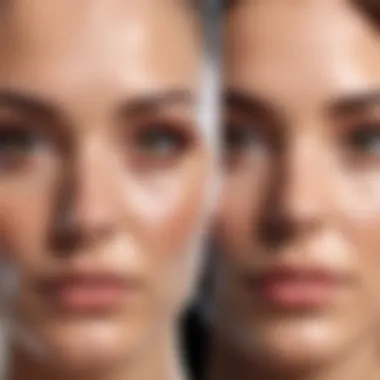Understanding Face Change Video Editing Techniques


Intro
In recent years, face change video editing has emerged as a significant technology in the landscape of digital media. This technique allows users to alter or replace facial appearances in videos, providing opportunities for creativity but also presenting ethical issues. This article aims to illuminate the complexity of face change video editing, its techniques, and its implications in modern media.
Overview of the Technology
Face change video editing employs sophisticated algorithms and machine learning. These tools enable users to manipulate facial features seamlessly in video content. The technology often integrates tools like deep learning and neural networks, which analyze facial structures and expressions to create smooth transitions.
Key specifications
- Facial recognition: The technology uses advanced recognition systems to identify and map facial points.
- Real-time editing: Some software allows modifications in real time, streamlining the editing process.
- Multiple face data: This helps in creating diverse options for face alterations, ensuring a wide range of expressive possibilities.
Unique selling points
Face change video editing is not only innovative but also customizable. Users can find various software and applications that offer unique features:
- User-friendly interfaces: Many tools require no advanced technical knowledge, accommodating a wider audience.
- Creative freedom: It allows users to explore identity and storytelling through altered visuals.
- Endless applications: From filmmaking to social media, this technology finds relevance in numerous fields.
Ethical Considerations
While the technology offers fascinating opportunities, it raises pressing ethical questions around authenticity and representation. Misuse of face change technology can lead to misinformation and undermine trust in visual media. Users must consider the impact of their edits on viewers and the potential consequences of altering someone else's likeness without permission.
Current Trends in Face Change Video Editing
Today, trends in face change video editing reflect wider movements in digital culture. The integration with platforms like Facebook and Reddit allows for easier sharing and interaction with altered content. Popular tools include Reface and DeepFaceLab, which continue to evolve and provide new features for users.
User Considerations
Manipulating facial appearances in video content demands a careful approach. Users should assess their intent, the context of their edits, and the potential risks involved. Balancing creative expression with responsible practices is vital in using face change technology effectively.
"As advancements in technology continue, so too will the responsibility of creators to engage ethically with their audiences."
End
As face change video editing becomes more accessible, understanding its mechanics, applications, and ethical considerations is crucial. This knowledge equips users to employ the technology thoughtfully and creatively, positioning them as responsible participants in the evolving landscape of digital media.
Preface to Face Change Video Editing
Face change video editing is a byproduct of modern technology that has been gaining traction in recent years. With the rise of social media and digital content creation, the ability to modify someone's face in a video can have significant implications. The relevance of this topic lies not only in its technical aspects but also in how it reshapes the way individuals express themselves through media. As video content becomes progressively more integral to communication and entertainment, understanding face change technology is essential.
Defining Face Change Technology
Face change technology refers to a set of methods used to alter a person's facial features in a video. This can range from simple adjustments, like changing the color of the eyes or the size of the mouth, to more complex modifications where one person's face is swapped with another entirely. This technology uses advanced algorithms coupled with artificial intelligence to detect and manipulate facial expressions.
Often, these methods rely on deep learning neural networks to ensure realistic results. The process usually involves facial recognition algorithms that enable software to understand the geometry of a face. Consequently, creators and editors can produce visually impressive modifications that, while fascinating, blur the lines of reality.
Historical Context and Evolution
The journey of face change technology mirrors the rapid evolution of digital media. Initially, video editing needed significant skill and was available to those with specialized training. Basic tools allowed users to make limited changes to visual content. However, as computer power increased, so did the sophistication of software tools.


In the early 2010s, simple apps emerged that made swapping faces in pictures and videos more accessible to the general public. This accessibility marked a critical shift. Today, platforms like Facebook and Reddit host numerous communities that share tips and tricks for face change techniques. Now, high-end options like Adobe After Effects offer comprehensive editing functions designed for professional use.
Understanding the historical progression of face change video editing is crucial. It underscores how technology can democratize creative expression, while also raising questions about the potential ramifications. As users experiment more with alterations, the potential for misuse increases, urging a need for awareness and education.
How Face Change Works
Face change video editing is a revolutionary technology that fundamentally alters how we perceive visual media. Understanding this topic is essential for those looking to explore the depths of digital editing and its various ramifications. This section delves into the technical mechanisms behind face change technology, as well as the software and tools that enhance its capabilities. The intersection of these elements illuminates both the practical applications and the broader implications for creators and audiences alike.
Technical Mechanisms
Facial Recognition Algorithms
Facial recognition algorithms are pivotal to the function of face change video editing. These algorithms analyze facial features and match them against databases to recognize and alter expressions accurately. A key characteristic of these algorithms is their capability to operate in real-time, enabling seamless editing. They benefit from high precision and quick analysis, making them a popular choice. The unique feature of facial recognition algorithms lies in their ability to learn from vast sets of data to improve their accuracy. However, there can be disadvantages, such as privacy concerns if misused in certain contexts.
Deep Learning and AI Integration
Deep learning and AI integration play a crucial role in improving the sophistication of face change techniques. These technologies allow for more nuanced and realistic facial modifications by employing layers of neural networks that analyze intricate patterns in facial movements. A significant characteristic of deep learning in this context is its adaptability, as it improves the editing process through continuous learning. The ability to create highly realistic edits distinguishes it in the realm of face change video editing. However, challenges include the substantial computational power required, which may limit access for some users.
Software and Tools for Editing
Popular Software Options
When it comes to face change video editing, there are several software options that stand out for their functionality and user-friendliness. Programs like Adobe After Effects and Reface app are among the most utilized due to their robust features. A distinct characteristic of popular software options is their combination of professional-grade tools with an intuitive interface, making them accessible for both beginners and advanced users. Each of these tools has unique features, such as real-time rendering in Adobe After Effects, which enhances the editing experience. Nonetheless, high costs can be a disadvantage when considering long-term projects.
Comparative Analysis of Tools
A comparative analysis of face change tools reveals significant variations in terms of capabilities, usability, and accessibility. Some tools emphasize ease of use, while others provide extensive features for professional editing. Comparing Adobe After Effects with apps like Instagram's filters shows how different user intentions shape their design and functionality. A key characteristic of such analysis is identifying which tools best align with specific user needs and project goals. Each tool comes with its advantages and disadvantages, including factors like price, learning curve, and output quality.
This comparison offers insights that can guide users in selecting the most suitable tools for their projects.
Applications in Various Fields
Face change video editing technology has diverse applications across several fields, emphasizing its versatility and significance in modern digital media. From entertainment to education, understanding these applications provides insight into both the current trends and future potential of this technology. This section investigates how face change technology reshapes various domains, highlighting specific elements, benefits, and important considerations.
Entertainment Industry
Film and Television
In film and television, face change editing plays a crucial role in enhancing storytelling. It allows filmmakers to modify actor appearances seamlessly, providing an avenue for creative expression. This capability enables producers to create scenes that would otherwise be impractical or impossible with traditional methods. The use of this technology can make characters appear younger or older, facilitating flashbacks or future scenes effectively.
A significant characteristic of this application is its capacity to generate realistic face alterations. This realism makes it a popular choice for special effects teams. Furthermore, it allows filmmakers to combine performances from various actors, creating unique character interactions without the need for complex logistics or reshoots. However, alongside these advantages, there are disadvantages such as the potential for audience misinterpretation regarding an actor's performance or a film's authenticity.
Social Media Content Creation
Social media platforms have increasingly adopted face change technology, enabling users to apply creative effects in real-time. This application appeals to content creators seeking to engage and entertain their audiences. Popular platforms like TikTok and Instagram offer filters that can morph faces, adding a playful element to user-generated content.
The primary characteristic of social media content creation is its accessibility. Users of varying skill levels can utilize these tools, fostering a widespread engagement with video editing. This ease of use makes face change technology a favorable choice for influencers and marketers aiming to capture attention. Nonetheless, the potential for misuse, such as the creation of misleading content, raises ethical concerns regarding its impact on viewers and brand trust.
Advertising and Marketing


Face change video editing is transforming advertising and marketing strategies. Brands leverage this technology to create tailored campaigns that resonate with diverse audiences. Personalized advertisements featuring altered faces can significantly enhance viewer engagement. This approach allows companies to present products in relatable contexts, addressing specific consumer needs and preferences.
Moreover, this application can reduce production costs. By using digital alterations instead of physical reshoots, companies can remain agile and adaptable in their marketing efforts. However, brands must remain vigilant about the ethical implications, ensuring that the portrayal of altered images does not mislead consumers.
Education and Training Tools
In the realm of education, face change video editing serves as a potent tool for training and development. Educational platforms incorporate this technology to create interactive learning experiences. For instance, virtual trainers can simulate real-world scenarios where learners can observe and practice reactions in a controlled environment.
The unique feature of using face change technology in education is its immersive nature. It allows students to engage with material in a visually stimulating manner. However, there are challenges to consider, such as the requirement for understanding the technology involved. Not all educators may be equipped to use these tools effectively, which could limit their potential impact in training settings.
"As technology continues to evolve, the applications of face change editing will likely expand, bringing forth new opportunities and challenges in diverse fields."
Ethical Considerations in Face Change Editing
As face change video editing technology becomes more accessible, the ethical ramifications of its use have gained prominence. Understanding these implications is crucial not only for creators but also for consumers and society at large. The ability to alter faces in video content raises significant ethical questions concerning privacy, misinformation, and the potential for abuse. By addressing these concerns, we can foster responsible usage and enhance public awareness.
Privacy Concerns
One of the foremost ethical issues related to face change video editing is privacy. The ability to manipulate someone's appearance in a video can infringe on personal privacy rights. For example, unauthorized use of a person’s likeness without consent can lead to potential misuse. If someone creates a video that modifies another’s face, this may cause reputational harm or emotional distress to the individual involved.
Furthermore, privacy is not limited just to individuals. Organizations and public figures often have their images edited without approval. This practice can erode trust and create an environment where authenticity is questioned. It is vital for creators to consider the implications of using someone's likeness and to seek consent wherever possible. Also, implementing regulations can help protect individuals from unwanted video modifications.
Misinformation and Manipulation
Another ethical concern linked to face change technology is the potential for spreading misinformation and manipulation. When videos can be edited to substantially alter representations of events or individuals, there is a risk of disseminating false narratives. This can profoundly affect public perception and lead to misinformed opinions.
Deepfake technology, a subset of face change editing, exemplifies this issue. Deepfakes can create realistic videos of people seemingly saying or doing things they never did. As such, this technology poses significant risks to political discourse, personal reputations, and broader social trust. Stakeholders must recognize the dangers of such manipulations and implement measures to identify and flag suspicious content.
"The interplay between technology and ethics is complex; as we innovate, we must also contemplate the ramifications of our creations."
Potential for Abuse
The potential for abuse in face change video editing cannot be overstated. This technology can be exploited for malicious purposes, such as creating non-consensual pornography or harassing individuals by altering their appearances in offensive or damaging ways. The anonymity provided by digital editing tools can embolden individuals to engage in unethical behavior.
Moreover, children and vulnerable populations are particularly at risk of becoming victims of such abuses. Thus, it is imperative that ethical guidelines and legal frameworks be established to mitigate risks associated with face change technologies.
In summary, as face change video editing becomes more prevalent, understanding the ethical considerations around its use cannot be overlooked. Addressing privacy concerns, combating misinformation, and preventing potential abuses should be at the forefront of conversation in the tech community and beyond.
Technical Challenges and Limitations
Understanding the challenges and limitations in face change video editing is essential for users and creators. This segment exposes critical elements that affect the quality and usability of this technology. Ignoring these aspects can lead to subpar results and frustration for users. Evaluating these challenges helps in making informed decisions, both for enthusiasts and professionals.
Quality of Output
The quality of output in face change video editing directly influences the effectiveness of the final product. Users expect a realistic portrayal when altering facial features in videos. Various factors contribute to the quality of output, including:
- Resolution: Higher resolution videos typically yield better results during editing. A low-resolution source can distort faces, leading to unnatural representations.
- Algorithm Proficiency: The facial recognition algorithms used in editing software can vary widely. Advanced algorithms produce cleaner, more accurate results, while lesser ones might struggle with capturing fine details.
- Lighting Conditions: Poor lighting during the original capture can adversely affect the editing process. Shadows, highlights, or glare can cause significant issues in accuracy.
Investing time in understanding these factors can improve outcomes significantly. This knowledge is valuable for anyone wishing to specialize in this technology. If the output does not meet expected standards, the efforts may not justify the results.


User Skill Level Requirements
The skill level required to effectively use face change video editing software varies considerably. Some tools are user-friendly, featuring intuitive interfaces that cater to beginners. Others demand a higher skill level for successful utilization. Important considerations include:
- Learning Curve: Many advanced programs require users to navigate complex features and settings. A steep learning curve can deter less experienced users from achieving desired results.
- Technical Knowledge: Understanding concepts like keyframes, masks, and layers is often necessary. Users without a technical background may find themselves overwhelmed.
- Practice and Experience: Just as with any skill, practice is crucial in mastering face change techniques. Spending adequate time with the software fosters proficiency but can rapidly consume time for users with limited availability.
Therefore, users must assess their skill levels and choose tools accordingly. Not every product is suitable for every user, and recognizing one's limitations is key to a successful editing experience.
Hardware Limitations
Hardware can significantly impact the performance and results of face change video editing. Users of high-end software may encounter challenges based on their system capabilities. Key hardware limitations include:
- Processing Power: Advanced editing often requires significant processing capabilities. Systems with lower processing power may experience lag and slow rendering times.
- Graphics Card: A dedicated graphics card can greatly enhance the editing experience. It allows for faster computation of graphic-intensive tasks. For those using integrated graphics, results may understandably suffer.
- RAM Availability: Insufficient RAM can restrict multitasking and slow down the editing workflow. Recommended specifications often lead to a smoother user experience.
Having a reliable hardware setup is essential for optimal performance. Users should evaluate their systems and upgrade as necessary. This approach can prevent users from encountering frustrating bottlenecks that hinder creativity and productivity.
"Understanding the technical challenges in face change video editing is not just beneficial; it's an essential part of mastering the technology."
By scrutinizing these challenges, readers can better grasp the intricacies of face change video editing and prepare themselves for effective engagement with this technology.
Future Trends in Face Change Video Editing
The landscape of video editing, particularly face change technology, is on the brink of rapid evolution. Addressing future trends is crucial for tech-savvy users and professionals alike. Understanding what to expect can help users adapt and leverage these advances effectively. Many factors contribute to the transformation of this field, including advancements in AI, increased accessibility, and ethical considerations.
Advancements in Technology
The progression of technology plays a pivotal role in enhancing face change video editing. With ongoing developments, algorithms have improved significantly over the years. Facial recognition has become more accurate, enabling realistic and seamless edits.
Deep learning models, such as Generative Adversarial Networks (GANs), are at the forefront. These models can analyze and mimic facial expressions with astounding fidelity. As a result, the quality of output is expected to rise, reducing artifacts and distortions that sometimes occur in less advanced software.
Moreover, hardware improvements, such as faster GPUs and increased RAM, will allow more complex processing. This means users can expect quicker rendering times and enhanced real-time editing capabilities. Software updates will likely integrate features that were previously reserved for specialized professionals, making the tools more user-friendly.
Implications for Content Creation
As face change technology becomes more sophisticated, its implications for content creation are significant. Creators can expect to push the boundaries of storytelling and artistry. The possible applications are diverse, engaging audiences in new ways.
- Increased Personalization: Users can tailor content to fit their brand or personal image, creating more targeted engagement.
- Enhanced Interactivity: Viewers may interact with videos that adapt in real-time, significantly changing how stories are told.
- Broader Creative Freedom: With improved capabilities, artists will experiment with styles and concepts that were previously challenging.
However, these advancements also prompt reflection on ethical considerations. There must be a balance between creative expression and responsible content creation. Users should remain aware of the potential risks of misinformation and manipulation.
"The future of face change technology offers unprecedented possibilities and challenges for creators and users alike."
In summary, the future of face change video editing is bright and promising. Expect to see more accessible tools, higher quality outputs, and innovative methods to engage with audiences. Keeping an eye on these trends will be essential for anyone involved in digital content creation.
Epilogue
In the fast-evolving landscape of digital editing, understanding face change video editing is crucial. This section reinforces the significance of this technology and its implications for various platforms and users. It highlights essential elements, benefits, and considerations that accompany its usage in contemporary media.
Summarizing the Impact
Face change technology marks a notable innovation within the realms of video editing and digital content creation. Its impact transcends mere aesthetics. It shapes narratives, influences perceptions, and alters storytelling techniques across various mediums. As filmmakers, content creators, and brands adopt these technologies, they harness the power of visual manipulation to engage audiences in new ways.
The technique can lead to innovative approaches in entertainment, advertising, and even education. However, while the advancements in this area present numerous opportunities, they also raise questions about authenticity and truthfulness in media. Creators must navigate these complexities to maintain a balance between creativity and ethical responsibility.
Encouraging Responsible Usage
With great power comes great responsibility, and this holds true in the context of face change video editing. As users adopt these advanced techniques, it is vital to prioritize ethical considerations. Content creators should be aware of the potential ramifications their work might have on audiences. The boundaries between reality and manipulation can blur, leading to misinformation or misuse.
Educating oneself about appropriate usage is essential. As a community, users should advocate for transparency and accountability in the content they produce. Establishing guidelines for what constitutes responsible editing will help foster an environment that prioritizes trust. Encouragement of responsible usage also means promoting an understanding of the emotional impact their media can have on viewers.







